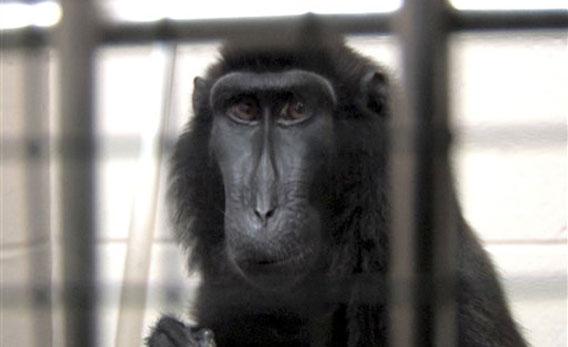Dozens of exotic animals, including 18 Bengal tigers, 17 lions, two grizzly bears, and a wolf ran loose in Zanesville, Ohio, Tuesday night, leaving schools closed the following day and many residents staying indoors. Around 50 animals were hunted down and either killed or captured, but one runaway macaque monkey remained at large. Authorities warned residents to keep their distance from the monkey out of fear that it may be carrying the herpes B virus, which can be deadly in humans. How does a monkey get herpes?
Monkey business. Nonhuman primates can become infected with herpes through biting, scratching, and having sex. Monkeys don’t kiss like humans do, but casual social behaviors such as touching nose-to-mouth and grooming can also spread the disease. While herpes B can be found in monkeys of all ages, it is most common among sexually active adults.
In monkeys, herpes B behaves almost exactly the same way that herpes simplex, the everyday human variety of herpes, behaves in humans. Most infected monkeys show no symptoms—which also means that they’re less contagious—but they may occasionally experience cold sores around the mouth or genital area. Just as in humans, once the virus enters the body, it never leaves.
Herpes B isn’t prevalent in all monkeys, but it’s endemic among macaques. Outside of captivity, these monkey species—which include rhesus monkeys, snow monkeys, and Barbary monkeys (sometimes referred to as Barbary apes)—live only in Africa and Asia. Herpes is not common among the monkeys of Central and South America. Among adult macaques in the lab, herpes seems to have infected more than half of all animals.
Monkeys can transmit herpes B to humans through all the same means with which they can infect one another—a bite, a scratch, a splash of saliva—or, in a laboratory setting, via an accidental scrape from a contaminated needle. While herpes B is relatively harmless among monkeys, among humans it can cause vomiting, headache, loss of motor control, and, eventually, infection of the central nervous symptom. Experts have documented at least 26 cases of herpes B infection in humans, at least 16 of which resulted in death. If left untreated, the estimated mortality rate is 80 percent.
Bonus Explainer: Are STDs common in the animal kingdom? Yes. Chlamydia is widespread among koalas, and is one of the reasons the species is threatened with extinction. HIV-like viruses have also been found among chimpanzees, and most scientists believe that HIV originated in other primates. Perhaps the most common STD among nonhuman animals is brucellosis, which affects many different animals including cattle, sheep, goats, pigs, deer, and dogs. In 1954, Brucella (the bacteria responsible for brucellosis) became the first agent of biological warfare weaponized by the United States. The program was later discontinued.
Got a question about today’s news? Ask the Explainer.
Explainer thanks Marina Cords of Columbia University.
